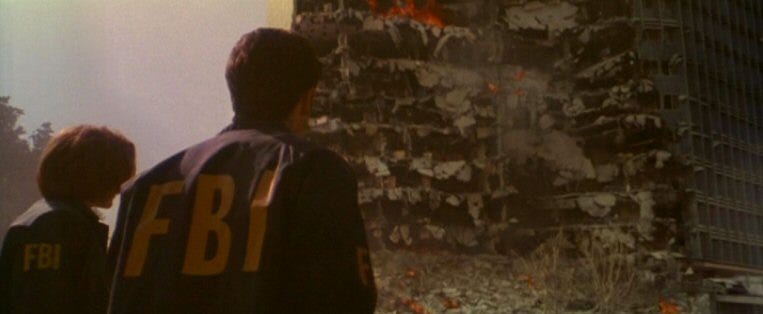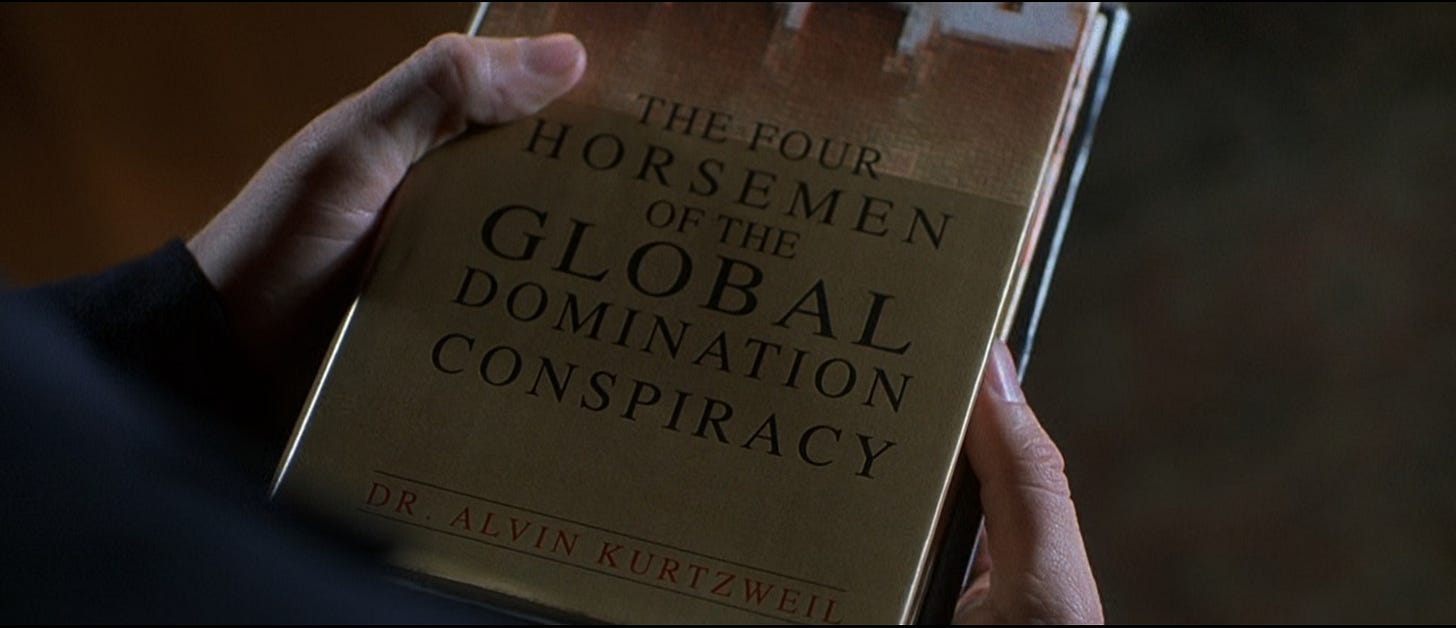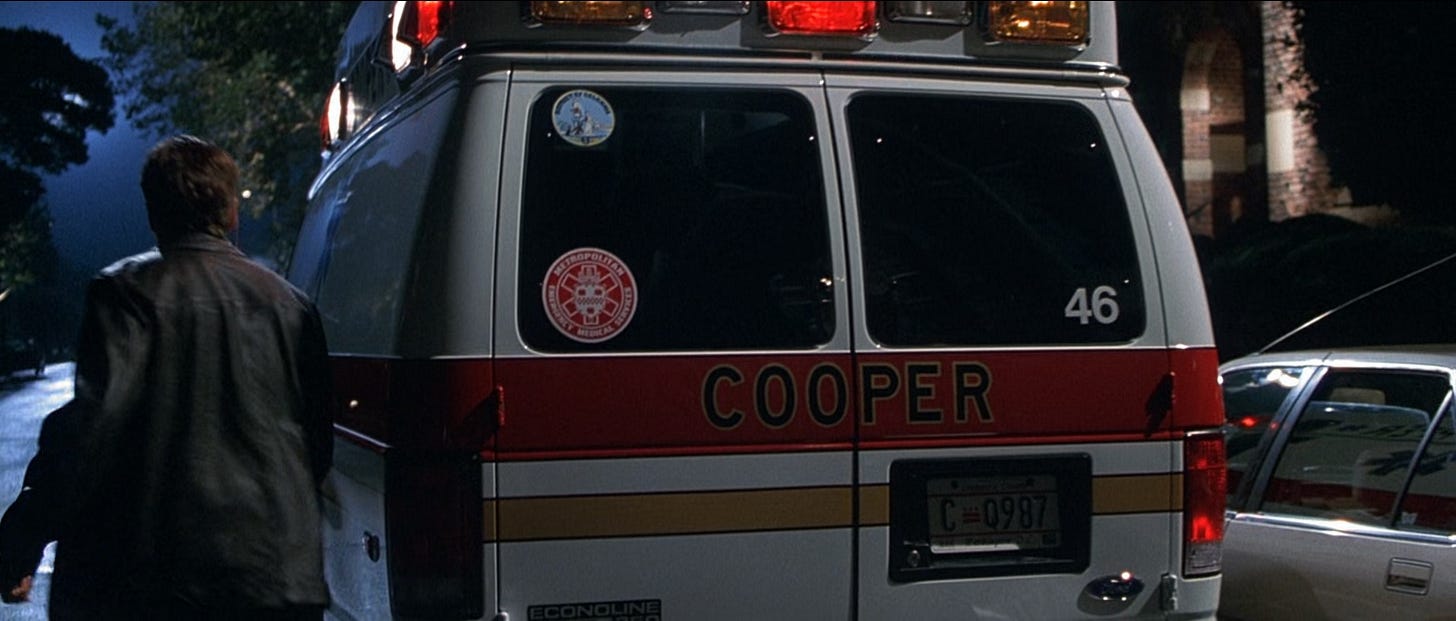Countdown to the Apocalypse
Tim McVeigh, The X-Files, Bill Cooper, and That Darn Doty
A recent read of mine, Wendy S. Painting’s 2016 book Aberration in the Heartland of the Real: The Secret Lives of Timothy McVeigh unpacks a facet of McVeigh’s personality that I have recently been obsessed with: He was an X-Files fan. From Painting:
The sponge-like McVeigh was an ardent X-Files fan, and after learning of the prosecution’s request to disqualify X-Files from the pool of potential jurors, he requested that his attorneys specifically include them on the jury and insisted that the defense jury-screening questionnaire include the question of whether or not the potential jurors were fans of the X-Files.1
Further, he had his attorney Randy Coyne tape and watch an episode with him to illustrate why these fans would be helpful on a potential jury—for they might share his conspiratorial nature: “McVeigh told Coyne the show was about ‘covert meetings in the night, secret goings-on’ and focused on a ‘ghost government.’”2 These descriptions also may reflect some of the conflicting stories McVeigh sometimes told about himself, specifically the claims about being part of secret units or special operations. Check out Painting’s Aberration for more on that matter.
What strikes me about McVeigh’s interest in the X-Files and the subsequent variety of stories alleging a conspiracy in the OKC bombing is that the X-Files themselves seems to acknowledge the bombing and the conspiracies in the world of the show. Not only that, but these ideas were also explored in the show’s feature film installment. In 1998’s The X-Files, (sometimes subtitled Fight the Future,) a major inciting incident in the film is Mulder and Scully—who have been taken of off the X-Files assignment—are sent to investigate a bomb threat at a Dallas federal building.
Narrative similarities aside, the blown-out building also eerily resembles the crime scene in OKC—a choice New York Times reviewer Janet Maslin calls one that “could have been the film's most shameless or daring aspect, but proves to be neither.”3 The visual parallels are impressively in sync: Special effects supervisor Ian Hunter says that his team “actually studied building demolition footage and the tragic Oklahoma City Federal Building explosion to see what kind of things happen to a building during a collapse.”4 Side-by-side images amplify the doubling effect.
The brazenness of modeling the fictional bombing of a federal building with a real life tragedy that occurred two years earlier is impressively bold, but even more so when The X-Files: Fight the Future’s version of the bombing is a false flag attack, an attempt to conceal the victims of a recently unleashed alien virus. The X-Files series, while no stranger to the conspiratorial, amplifies the connections to real world conspiracy culture in the feature film by including a character seemingly modeled on Milton William Cooper. An early spreader of UFO community disinformation, Cooper is a major throughline from UFO enthusiasts to the militia movement and was an early proponent of the theory that the OKC bombing was a false flag attack. As explored by Painting, Cooper’s Behold a Pale Horse “amalgamated nearly the entire history of UFO alien narratives (…) that had been circulating in fringe subcultures for quite some time,” sharing rhetoric with “Patriot, Militia, and white supremacist” communities. Painting notes that “Cooper made the rounds in those circles as well,” eventually focusing more on that conspiratorial angle “after the UFO crowd began to scorn and debunk him.”5 Furthermore, like The X-Files, Cooper was a major influence on McVeigh—“when his attorneys asked him what public figures might help them understand his way of thinking, William Cooper was one of the people (McVeigh) said they might want to talk with.”6
Before the move to more NWO-centric conspiracies, however, Cooper’s UFO mythology bore many similarities to those promulgated by those involved in the Bennewitz affair (explored in Pt. 2 of The Bosco of Brazil) such as John Lear and Richard Doty. Painting calls it “directly traceable to, if not wholly grafted from, the fabricated disinformation fed to Paul Bennewitz, and through him, the larger UFO/contactee community.”7 Some viewed Cooper himself as one of the many “Mirage Men” sowing disinformation and overall confusion throughout the UFO sphere. (I tend to think this is probably the case.) It is then maybe no surprise that Cooper’s outlandish and science-fictional mythology made its way into The X-Files feature film.
In said film, Alvin Kurtzweil (Martin Landeau) is the character referential to Cooper. He is presented as an OB-GYN and conspiracy theorist who seeks out Mulder to inform him that the bombing of the Dallas federal building was a false flag attack, meant to distract from and cover up deaths caused by an alien virus. Additionally, Kurtzweil informs Mulder of the nefarious intentions of FEMA who set up a camp in the Texas suburb where the alien virus outbreak began. Cooper was eager to decry the NWO-spawning capabilities held by FEMA, writing in Behold a Pale Horse that “‘emergency management’ is just a guise for its real purpose, which is to take over local, state, and federal government in case of a national emergency.”8 Linda Thompson, who warned of Jolyon West brainwashing McVeigh in prison, was also a promoter of the FEMA camp narrative, with Cooper likely borrowing some of her material from her talks about the topic on Cooper’s radio show. When Kurtzweil is framed for child pornography by the antagonistic Syndicate for revealing too much of their plan to Mulder and the public, we are granted a shot of two of Kurtzweil’s fictional books, Countdown to the Apocalypse and The Four Horsemen of the Global Domination Conspiracy. The latter of these is reminiscent of Cooper’s Behold a Pale Horse and both certainly match the tone of Cooper’s writing.
To drive the point home, Kurtzweil remarks that the coming alien plague is “a silent weapon for a quiet war,” which references a purported leaked military intelligence document that serves as Chapter 1 of Behold a Pale Horse. A fake ambulance that the Syndicate uses to kidnap the recently-infected Agent Scully has a decal that reads “COOPER” which by some stretch of the imagination could be indicative of Cooper’s status as a Mirage Man.
Cooper is an interesting choice for The X-Files: Fight the Future to model a character on specifically because his film counterpart is not the militia/patriot boogieman of 90s American news media. Rather, Kurtzweil/Cooper is mostly correct in his assumptions of government/alien interaction, having extensive knowledge of the series’ big baddies the Syndicate. The film on the whole seems to crib many plot points from the patriot/militia/UFO subcultures, a brash choice for a major motion picture based on a show that was a cultural phenomenon at the time. But here’s where the room really starts spinning: One of the “Mirage Men” profiled in Mark Pilkington’s book of the same name claimed to have been involved with The X-Files TV series. Richard Doty, who targeted Paul Bennewitz with fabricated further UFO and contact experiences, claimed that he “had worked as a consultant for The X-Files and Steven Spielberg’s alien abduction series Taken”—supposedly also appearing as an vampire extra in an X-Files episode.9 While the latter of these statements seems to be bunk according to my numerous X-Files-obsessed friends, the claim about consulting is unconfirmed by anyone not named Rick Doty. Given how readily the feature film adopted the mythology of Mirage Man-influenced Bill Cooper, it would not be surprising if Doty truly did work as an X-Files consultant. Among himself, Bennewitz, Cooper, John Lear, and others, the UFO narrative has been consistent variations on similar themes—almost all of which appear in The X-Files film and TV show.
Given that McVeigh was soaking up The X-Files and Bill Cooper, it becomes fascinating prospect that both the show and Cooper were being fed UFO information by Richard Doty, AFOSI, or other military intelligence. It becomes even more bizarre that the X-Files movie seems to be taking cues from not only alternate OKC bombing narratives, but also gives a respectful nod to Bill Cooper’s work when he was viewed as one of the most dangerous men in America post-OKC. The significance of all of these references and influences circulating through The X-Files, the UFO community, Timothy McVeigh, the OKC bombing, Bill Cooper, and Richard Doty is not immediately apparent but the whole web represents the overlaps between these various subcultures well—the broader paranoid 90s milieu. Likewise, it emphasizes the “wilderness of mirrors” nature of these communities and the ideas circulating through them. It’s a maddening jaunt through fact, fiction, disinformation, and all the grey areas in between. Pun not originally intended but I’m sticking with it.
Thank you for reading Getting Spooked, hope you enjoyed this brief detour away from the Bosco series. If you like what you have read so far and want to support the publication, think about picking up a paid subscription or drop a one-time donation on ko-fi. Be sure to follow on Twitter (@TannerFBoyle1) and spread the word if you think any of your friends might enjoy these forays into the weird and parapolitical. Until next time, stay spooked.
Painting, Wendy S. Aberration in the Heartland of the Real: The Secret Lives of Timothy McVeigh. Walterville: Trine Day, 2016. Page 236. Available here.
Ibid.
Maslin, Janet. “The X-Files: In the Dark, It Resembles a Conspiracy.” The New York Times, 19 June 1998, https://archive.nytimes.com/www.nytimes.com/library/film/061998x-files-movie-review.html
Failes, Ian. “Splosions! and the X-Files Movie.” Before and Afters, 20 March 2020, https://beforesandafters.com/2020/03/20/splosions-and-the-x-files-movie/.
Painting, Wendy S. Aberration in the Heartland of the Real: The Secret Lives of Timothy McVeigh. Walterville: Trine Day, 2016. Page 332.
Ibid., page 329.
Ibid.
Cooper, Milton William. Behold a Pale Horse. Flagstaff: Light Technology Publishing, 1991. Page 115.
Pilkington, Mark. Mirage Men: A Journey in Disinformation, Paranoia and UFOs. London: Constable, 2010. Page 189.








We always got a Jim Marrs vibe from the Kurtzweil character but Cooper makes a lot of sense. Great write up!
Very interesting.
I have one request, would you consider using a black words on white background? It would be easier on the eyes :)